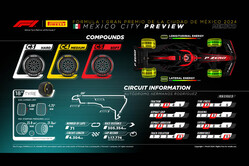 The second stop on Formula 1's long trip to the Americas takes place in the Mexican capital, Mexico City, before the circus moves onto Sao Paulo to end the run of three consecutive races.
The second stop on Formula 1's long trip to the Americas takes place in the Mexican capital, Mexico City, before the circus moves onto Sao Paulo to end the run of three consecutive races.
At the circuit named in honour of the brothers, Pedro and Ricardo Rodriguez, the available tyres are the C3 as Hard, the C4 as Medium and the C5 as Soft, a step softer than in the past, as was already the case last year, the decision taken in order to open up more strategic options for the race.
The first day of track action, Friday 25 October, will be slightly different to usual. The second free practice session will be entirely given over to validating the softer compounds in Pirelli's 2025 range (C4, C5 and C6) in what is known as an in-competition test. The session is extended by 30 minutes to 90 and all drivers and teams will have to follow a specific programme established by the Pirelli engineers. Apart from the dry tyre allocation specifically for the Grand Prix (two sets of Hard, three of Medium and seven of Soft, one less than usual), each driver will have two additional sets of tyres: one will be identical to the one available for the weekend, to act as a baseline, while the other will be a 2025 prototype option, both in terms of compound and of construction - actually the latter already homologated back in September.
These two sets will not have any sidewall colour bands. The plan is for the programme to include a performance run and a long run for each set, with every team running the same number of laps with the same quantity of fuel on board, dependent on the type of run. The only exception will be in the case of a regular race driver being replaced for FP1 by a young driver. These race drivers will carry out the Pirelli test for 60 minutes of FP2 only and will have an additional set of Medium compound tyres to catch up as much as possible on acquiring data for the rest of the weekend. All the test data will then be analysed by Pirelli engineers to fine tune the characteristics of the compounds prior to the group test in Abu Dhabi, which starts on the Tuesday after the final round of the 2024 championship. It means that teams will have to prepare their cars for qualifying and the race in the space of two hours: FP1 on Friday and FP3 on Saturday.
The Hermanos Rodriguez track is 4.304 km long, with 17 corners and a surface that is low in terms of its severity on tyres. This year the promoter has resurfaced the section between turns 12 and 15 in the third sector. The very smooth asphalt and the fact the track is hardly used means that grip levels are rather low at the start of the weekend and track evolution is very marked, rubbering in the more the cars run.
Mexico City is located at over 2000 metres above sea level and the rarified air has an influence on car performance, reducing the aerodynamic downforce generated by the cars. One of the consequences of this is that top speeds reached are very high, despite a configuration that actually looks typical of tracks that require maximum downforce - the speed record was set here in 2016 when Valtteri Bottas in the Williams-Mercedes was clocked at 372.5 km/h - even if the level of graining is usually quite high. Furthermore, on the longest straights, the main one and the one between turns 3 and 4, the surface temperature of the tyres tends to drop pretty quickly and the drivers have to be very careful when braking, especially at turn 1, to avoid locking the wheels and therefore damaging the tyres.
In terms of strategy, this is usually a one-stop race. Last year, the majority of drivers tried to manage the Medium to lengthen the first stint as much as possible. A Safety Car and a later red flag, after Kevin Magnussen went off the track in the Haas, meant that nearly the entire field used three sets of tyres in a race that was pretty much divided in two.
Formula 1 has always been very popular in Mexico, even if there have only ever been 23 championship races held here, all of them at this circuit in the capital city, inaugurated in 1962. The races took place in three periods: from 1963 to 1970, from 1986 to 1992 and from 2015 onwards. A change of name in 2021 saw the Mexican Grand Prix renamed after the city.
There have been 15 different winners over the 23 editions of this race. Max Verstappen is the most successful driver with five wins, with his Red Bull team on the same number heading the teams' classification. Jim Clark has started from pole the most often (four times) while Lewis Hamilton has the most podium finishes with six. Of the constructors, Lotus on 6 has the most poles and Ferrari leads the way for podium finishes with 12.






















sign in